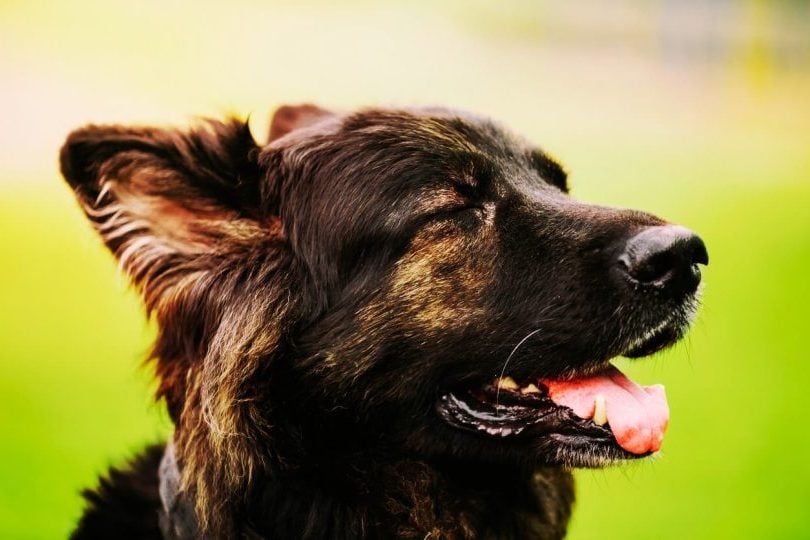- Not a substitute for professional veterinary help.
Most people can barely move their ears at all, except for the lucky few who can wiggle them. But your dog’s ear position can convey a fair amount about their feelings and responses to specific situations.
Dogs, wolves, and other members of the canid species all use ear communication, according to Dr. Mindy Waite, Ph.D, CAAB, a certified dog behaviorist. To put it simply, your dog’s ear movements stem from their genetics, though interactions with humans and other animals can shape the way they communicate with their ears.
That said, ear shapes differ a lot between dog breeds. So, your dog’s ear position can’t always tell the whole story when it comes to their mood. They also use other types of body language, like certain postures and behaviors, to communicate.
Ready to become an expert on your dog’s ear language? Check out the chart below!
Dog Ear Positions Chart
Dr. Waite shares her expertise to help explain common dog ear positions, which you’ll find in the table below:
| Ear Position | Meaning | Accompanying Behaviors |
| Relaxed | Neutral, relaxed, unconcerned | Soft eyes, soft mouth that may be gently closed or slightly open, loose body, loose hips, possibly loose tail wag. |
| Flattened or pinned back | Uncomfortable, concerned, uncertain | Tail down, slightly worried eyes, wrinkles in forehead, mouth closed or panting. |
| Extremely flattened or pinned | Extremely uncomfortable. May desire to avoid or escape situation. May potentially become aggressive | Low and forward body, perhaps in preparation to escape or aggress. Tail may be stiff and still or wag stiffly. Stiff body with hackles up. |
| Perked (Tensed and forward) | Highly aroused. Dog is either about to move forward aggressively or chase something. |
Stiff body, staring eyes, mouth closed. |
| Pointed (Tensed and flattened. | Highly aroused. Dog is either about to move forward aggressively or chase something. |
Stiff body, staring eyes, mouth closed. |
| Switching between positions | Unsure about situation and how to respond. | Darting eyes, varying body positions, may move forward and backward. |
5 Dog Ear Positions And What They Mean
Dr. Waite emphasizes that reading your dog’s ear language can depend a lot on their breed.
Dogs like German Shepherds have flexible pointed ears they can easily move into positions that your eyes can clearly see. As a result, you’ll notice more of a range of expression in their ears than you might from a Beagle or Basset Hound, both of which have large floppy ears.
Other types of dog ears that may limit communication include hidden ears, tall and stiff ears, and cropped ears.
Dr. Waite elaborates on the chart above by sharing five different ear positions and what they might mean for your dog’s mood—and how you, as a pet parent, can help them!
Relaxed ears
If your dog feels comfortable and at ease in their surroundings, their ears will likely show this with a relaxed position. You’ll probably also notice a lack of tension in the rest of their body.
For example, you might notice relaxed ears when hanging out with your dog at home.
Flattened or pinned ears
Are you introducing your dog to something they’ve never encountered before? This could be anything from a new partner to a new washing machine. Unfamiliar surroundings can make your dog feel uncomfortable and unsure, and they might show this skepticism with flattened or pinned ears.
Keeping your own body language positive and happy, and speaking in a calm voice, can help reassure your dog that everything is OK. It will also help to let them take some long, thorough sniffs of the “intruder” to help them make sure they (and you!) are safe.
Extremely flattened or pinned
Your dog may pin their ears back—flatten them close along their head—in a situation where they feel very uncomfortable or uncertain. For instance, this might happen when:
- They realize you’re taking the road to the vet’s office
- They encounter a big, noisy crowd
- You take them on public transport for the first time
- Dogs who have experienced abuse encounter a situation that reminds them of past trauma, like when someone yells
In these types of situations, it can help to try soothing your dog as much as possible. Some good techniques for comforting your dog include distraction, petting, and scent therapy.
If possible, it may also help to remove your dog from the situation as soon as possible.
Perked or pointed
Depending on your dog’s breed and ear shape, this position may appear as if your dog is pointing their ears forward or flattening them.
In either case, it means your dog is highly aroused by some kind of stimulus—which could be something that excites them or something that sparks aggression.
For example, you might notice this ear posture when you’re about to throw your dog a ball—or when they meet a dog they don’t like.
If you notice your dog points their ears in aggression often and also shows other aggressive behaviors, it’s crucial to train your dog to prevent dangerous situations. You can always seek help from a certified dog behaviorist for training guidance.
Switching between positions
Are your dog’s ears all over the place?
This may happen in an environment that’s full of new noises, smells, and movements where your dog doesn’t know how to respond. Their ears will move about trying to listen to everything going on, and the rest of their body language will mimic this.
Do Ear Positions Always Mean Something?
Do dogs stand their ears up to appear bigger and scarier in front of adversaries? Or flatten them to become smaller to dodge attention?
Dr. Waite explains that experts still have plenty to learn here. She goes on to emphasize that the main purpose of ears is hearing, not communication.
In short, your dog isn’t necessarily pricking their ears in an effort to communicate. They may simply be trying to pick up some interesting sounds more clearly!
Ups And Downs: How Dog Ear Positions Develop From Puppyhood
Ever wondered why some dogs have floppy ears and others have pointed ears? Or perhaps you’re curious why your dog has one ear up and one ear down.
The extent to which a dog’s ears stand erect mostly relates to their genetics, explains Dr. Jamie Whittenburg, DVM, director of Kingsgate Animal Hospital in Lubbock, Texas.
Often, in breeds whose ears typically stand up, puppies have floppy ears at first. As they grow, the cartilage will stiffen and eventually give the ears an upright position. Things that may affect ear growth and positioning include nutrition, trauma, parasites, and ear infections.
Most of the ear’s ability to stay permanently erect comes from the composition of the cartilage in the outer ear—which, it might go without saying, your dog can’t control at all. Muscles only control some of the ear’s height and movement. As dogs that typically have upright ears mature, the cartilage and the muscles further develop to help their ears stand up.
You’ll typically notice ears with a one up, one down appearance in young dogs who have yet to fully develop ear cartilage and muscle. In adult dogs, this may be due to an injury or your dog’s genetics.
And remember, no matter what your dog’s ears look like—floppy, erect, one of each, or even ears with a pocket—they still require regular cleaning!







